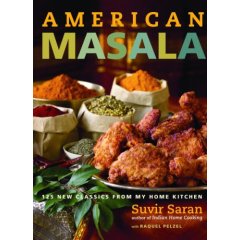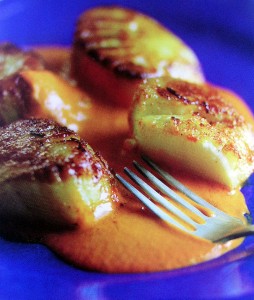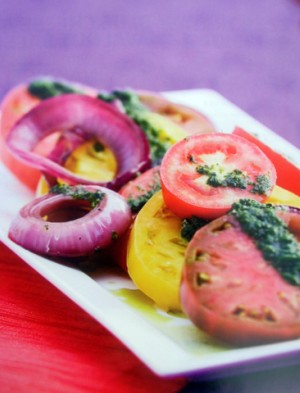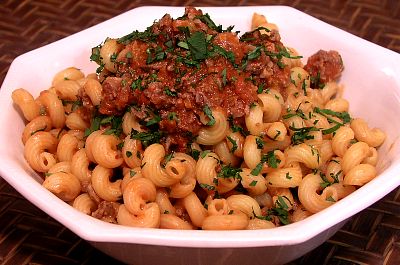Recipes from the Rim: Part II
November 5th, 2007
American Masala
125 New Classics from
My Home Kitchen
Suvir Saran with Raquel Pelzel
Clarkson Potter (October 2, 2007);
272 pages; $35.00
Known for his Manhattan Indian-fusion restaurant, Devi, the effusive Suvir Saran takes mainstream American dishes (or once-ethnic dishes that have become mainstream) and infuses some of them with Indian spice and Indian techniques. He also takes inspiration from Mexican, Mediterranean, and North African kitchens.
So, we get Tamarind-Glazed Meatloaf, Turkey Hash Masala, Shrimp Scampi Masala, Indian Eggplant Caponata, and French Toast (with cardamom). There are some very rich, if tame, comfort foods—and a lot of cheese (Parmesan, Gouda, taleggio, fontina, ricotta). Cheese is not a huge feature of Indian cooking, but Mr. Saran is clearly enraptured by it. Two and one-quarter pounds of three different cheeses ensure that his mild Macaroni and Cheese (serving 8-10)will make some people very happy.
Roasted corn on the cob (Chaat Masala Corn with Lime) would make more people happier if there were a guideline for making this sour and salty seasoning blend. We’re glad to see a recipe for Mr. Saran’s version of Garam Masala, but someone forgot to include one for Chaat Masala; at bare minimum, there should be a description of it. (A basic chaat masala would include toasted cumin, coriander seed, black pepper, red chili, powdered mango, asafoetida, and the distinctively sulphurous Indian kala namak, “black salt.”)

Scallops with Roasted Pepper Chutney
Photograph by Ben Fink for American Masala
It’s clear that Mr. Saran loves to entertain, but I will take issue that roasting vegetables in the oven for an hour (and then to purée them as a dip) is what anyone—pro or not—does to whip up a snack for unexpected guests. And I am mystified as to why his skillet corn bread uses a package of prepared corn-bread mix, unless it is some secret, unswerving homage to the recipe’s originator, one Grandma Hayes.
Nonetheless, the spirit of American Masala is contagious. The recipes illustrate that appreciation of flavor occurs at many levels and that spice does not have to mean heat. Though he is a restaurant chef, Suvir Saran delights in preparing food at home and demonstrates that it’s both practical and fun for home cooks to have a global pantry.
Suvir Saran’s engaging anecdotes (Raquel Pelzel is credited as his co-author) make it clear that he grew up in an affluent and well-educated Indian family with their own cook. In contrast, Puerto Riquena-American Isabel Cruz was raised in a polyglot Los Angeles neighborhood of Caribbean, Latin American, Japanese, and Thai immigrants. In the next post on fusion cooking, I will look at her new book, Isabel’s Cantina. —Holly Chase
Note: Clarkson Potter sent us this book for review
Recipes from the Rim: Part I
October 31st, 2007
Heirloom Tomatoes with Olive Oil-Cilantro Sauce
Photo by Gregory Bertolino for Isabel’s Cantina
Fusion food: It’s a natural development in a world where people travel for work and recreation. And even if they stay home, many people see glossy travel and lifestyle magazines with gorgeous food photos, cooking shows on TV, and what we call “food porn” on the Web. American supermarkets, specialty grocers, mail-order businesses, and farmers’ markets now sell ingredients that twenty years ago were not readily available to those living outside major multicultural urban areas. Even in rural areas of the American heartland, convenience stores now sell beer and wines from Australia and Latin America.
As in music—Afro-Celt pop, Polish Reggae, or Yo-Yo Ma’s Silk Road Project—fusion has become a flavor. Sometimes the results are brilliant, and sometimes they are discordant, ill-conceived, and, ultimately, unsatisfying.
One is reminded of the scene in the film Amadeus: Mozart has just played a little harpsichord divertimento for his patron, the Emperor Franz Josef. The Emperor, not the brightest flame in the candelabra, is bewildered by the virtuoso brilliance. He shakes his head and mutters, “Too many notes!”
And that’s our feeling, too, when we see restaurant menus on which each dish requires several lines of text. Here are two offerings reprinted exactly as they appear on current menus of two very hot restaurants—the first in Florida, the second in California.
Grouper Cheeks Sous Vide Faux Watermelon, Jasmine Froth, Amaranth, Torn Herbs, Cucumber Vinaigrette
Salad of “Compressed” Kohlrabi Moro Blood Orange “Confite,” Red Radishes, Mizuna Leaves and Black Sesame “Coulis”
One can say that the popularity of fusion is partly due to the simple fact that it is now possible to combine sounds and tastes from around the globe. If musicians mix Tuvan throat singing with bluegrass and chefs sauce lutefisk with lemongrass, it’s because they can. Whether they should is something listeners and diners eventually determine.
With a different audience each night, a musician or a restaurant chef can see how his creations are received. It’s easier for a restaurant cook to test combinations than it is for someone who has another life and comes home from a day job to prepare a family supper. The recreational home cook who entertains on the weekends may or may not want make his guests guinea pigs for a sea-urchin mousse with wasabi pappadams. (Honestly, I just made that up, but I’ll bet the combo exists on a menu somewhere in NY or LA.) With concoctions like that, the home cook rarely gets a second chance to make a first impression. If the flight of fancy does not work, it’s not likely that he’ll spring it again on his friends. On the other hand, the restaurant chef can tweak things and continue to work on a dish, serving it over and over, with variations, until he gets it right.
In the many books, magazines, online columns, and menus that we see each week, I read recipes and descriptions of scores of fusion dishes. Whether I try them out or not, it appears that, despite the sheer silliness of recipes like those cited above, the better-crafted fusion recipes are coming from restaurant chefs, and that’s probably because they’ve had the theatre in which to develop them.
And since I tend to cook this way, I enjoy fusion food publications—they serve to both confirm and inspire food that I prepare myself.
There are a lot of fusion cookbooks out in the firmament right now. In the next post, I’ll be discussing two newly-released books by chef-restaurateurs. Each is beautifully produced with seductive photos—presentations shot on just the right cobalt plate or wooden platter.
Tune in later this week for commentary on American Masala by Suvir Saran and Isabel’s Cantina by Isabel Cruz, both published by Clarkson Potter.
By Holly Chase
Pasta con le Regaglie
October 25th, 2007I recently came into possession of some turkey giblets. The whole deal had an undercover quality I loved. A chef friend was preparing Turkey Divan and had no use for them. But she extended the offer, sotto voce, perhaps because she wasn’t sure if I even liked turkey giblets. Her referring to them as “body parts” added to the intrigue. I confess: this wasn’t the first time I’d been involved in a deal like this.

Years before, when I lived in Boston, my upstairs neighbor had been a cook at Jasper’s on Commercial Street. Jasper White had created a culinary niche cooking upscale versions of classic New England dishes. From time to time, my neighbor called me at work, and in a conspiratorial tone, informed me that Jasper would be making his lobster rolls that evening. I’d then make a beeline to Jasper’s at the end of my workday, sit at his small bar, and make short work of at least one of those lobster rolls, which were well worth being part of any kind of conspiracy, real or imagined. But I digress…
Though few would place turkey giblets in the same class as lobster, they too have limited availability. They are not the kind of foodstuff readily available at the local supermarket unless they come packaged in a turkey. So my little “score” was a particular treat. And for me anyway, the destiny of poultry giblets is always preordained: Pasta con le Regaglie. (reh-GAHL-yay)
In the interest of full disclosure, I confess that, for many years, my attempts at Pasta con le Regaglie have ranged from dismal failure to merely mediocre. In fact, for a long time I felt like Charlie Brown kicking that football. Each time I tried it, I knew in my heart that it was going to be great. Each time, I wound up on my back.
The problem with giblets is their inherently gristly texture—about as appealing as elastic bands. It seemed that no matter how thoroughly I dissected the giblets, or how diligent I was in removing connective tissue, I couldn’t lose the gristle.
So I spent some time studying Italian recipes; it seemed my problems related to the length of time I cooked the giblets. It turns out, this dish wants to be cooked for a long time. And my love for Pasta con le Regaglie gave me the courage to give it one more try.
The dish captivated me decades ago at a trattoria in Rome and has haunted me since. But I believe that finally, with this recipe, I’ve captured it. The giblets create an intense, rustic and earthy tomato sauce, while the livers add creamy and sophisticated depth.
Despite the fact that Caterina de’ Medici—who spent some quality time as Queen of France—is said to have enjoyed a giblet ragù with cockscombs now and then, this dish is a supreme example of la cucina dei poveri, the cooking of the poor.
Pasta con le Regaglie
Pasta with Giblets
Ingredients:
1 1/2 Lbs. Giblets (chicken or turkey)
2 Cloves garlic, peeled
1 Medium carrot, peeled and cut into chunks
1 Stalk celery, peeled and cut into chunks
1 Medium yellow onion, quartered
3 Tbs. Italian flat-leaf parsley, including stems
2 Oz. Pancetta, roughly chopped
2 Tbs. Extra-virgin olive oil
1 Cup dry white wine
1 28 Oz. Can crushed or diced Italian plum tomatoes (preferably San Marzano)
1/2 tsp. Crushed red pepper flakes
Salt & freshly ground black pepper
1 Lb. Rigatoni, or other large tubular pasta (cavatappi, penne, mostaccioli)
4 Tbs. Flat-leaf Italian parsley, finely chopped
Freshly grated Pecorino-Romano
Preparation:
Remove all connective tissue, visible fat, and silverskin from the hearts, gizzards, and livers. Chop into very fine dice and reserve.
Place the garlic, carrot, celery, onion, parsley with stems, and pancetta in the bowl of a food processor and pulse ten or more times for about one second for each pulse. The resulting mixture is known as a batutto.
Heat a four quart pot over medium heat, then add the oil. Add the batutto and cook for approximately ten minutes, until the vegetables have softened and the pancetta has rendered its fat. Lower the heat if the vegetables begin to color.
Add the giblets to the pot, and continue cooking, shaking the pot from time to time, until the giblets have lost their pinkish color.
Raise the heat to high and add the wine. Continue cooking over high heat until the wine is reduced by half.
Reduce the heat to medium-low and add the tomatoes and the red pepper flakes. Adjust heat so the sauce simmers gently; season with salt and pepper. Simmer, with the pot-lid slightly ajar, for approximately one hour, or until the sauce has thickened and any clear liquid has cooked off.
Approximately fifteen minutes before serving time, bring a large pot with salted water (at least six quarts) to the boil. Add the pasta and cook until it has just reached the al dente state. Remove from the heat and drain in a colander.
To Serve:
Divide the pasta equally among four plates and pour a ladle or two of sauce over each portion. Garnish with the remaining parsley and pass the Pecorino-Romano separately at the table.
Trick or Treat?
October 19th, 2007Ordinarily, I enjoy starting my day with the online edition of The New York Times. Oh sure, I’m as upset as anyone else reading about wars, stock market gyrations, and the fate of the Yankees’ Joe Torre, but once in a while, a story causes me to scratch my head and wonder, “How did it get this far?” Today’s Times features just such an article.
Jessica Seinfeld—wife of comedian Jerry, and apparently an otherwise upright citizen—has written a cookbook, “Deceptively Delicious,” published October 5, 2007, by Collins (an imprint of Harper Collins). It’s a manual of culinary subversion that tells parents how to flim-flam their children into eating things like spinach cooked into brownies. On the surface, this seems a worthwhile endeavor, although I’m old enough and reactionary enough to believe that if children are fed well from the start—with a moderate, well-balanced diet—one can achieve the same results without subversion. But that’s not the issue here.
One Missy Chase Lapine—former publisher of Eating Well magazine—wrote a cookbook called “The Sneaky Chef,” published April 4, 2007 by Running Press. Ms. Lapine’s cookbook is also aimed at flim-flamming children into eating spinach cooked into brownies. Her cookbook predates Ms. Seinfeld’s by no less than four months. Prior to publication by Running Press, Ms. Lapine had submitted a 149-page proposal, including 42 recipes, to Harper Collins—twice. Each submission was rejected.
In their attention to this story, The Times article used the word ‘coincidence’ twice. Columnists Rush and Molloy, writing in today’s New York Daily News, use a stronger word.
But when I read stories like this, I can’t help thinking about, say, bankers with MBAs offering sub-prime mortgages to people who wouldn’t qualify for membership at their local video rental stores. Again, my point is, how did it get this far?
The Times‘ Motoko Rich writes,
Did no one at Collins see that another cookbook, very similar to Ms. Seinfeld’s, that they had already rejected, had just been published? How did it get that far?
Mr. Rich also writes that Collins and Running Press had communicated about Ms. Seinfeld’s book in advance of its publication:
Awkward? Does anyone else remember Rosemary Woods and the eighteen-minute gap in the White House tapes?
Hmmmm….I don’t know. But if I’d been an editor at Collins, I would have asked Running Press for an examination copy of Ms. Lapine’s book. And if they’d declined my request, I would have sent an intern down to the nearest Barnes & Noble with a few bucks from petty cash.
Nonetheless, as publisher Steve Ross noted for Rush and Molloy, “Collins U.S. has six printing presses going full time to keep up with demand.” The New York Times has announced that a week from Sunday, Ms. Seinfeld’s cookbook is expected to be number one on “the hardcover Advice, How-To and Miscellaneous” best-seller list.
And in the weeks to come, I suspect PR firms with expertise in risk mitigation and damage control will be consulted. Perhaps Ms. Seinfeld will graciously offer to turn over the proceeds of her book to Baby Buggy, the children’s charity she founded. It’s a good bet that gleeful hand-rubbing and chop-licking have already begun at New York law firms specializing in intellectual property litigation.
It’s all about due diligence. Whether you originate loans or cookbooks—bankers, editors, publishers, lend me your ears! How did it get this far?



